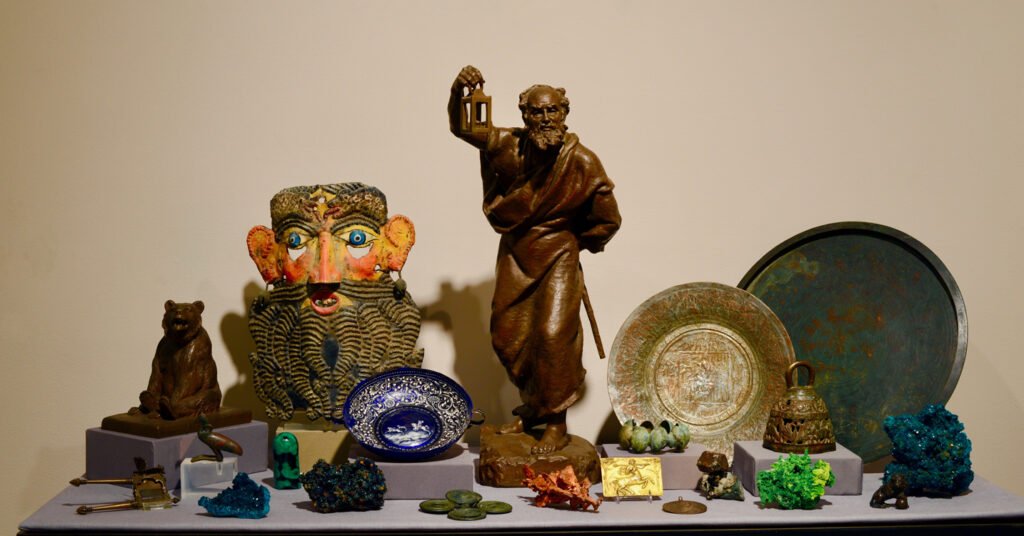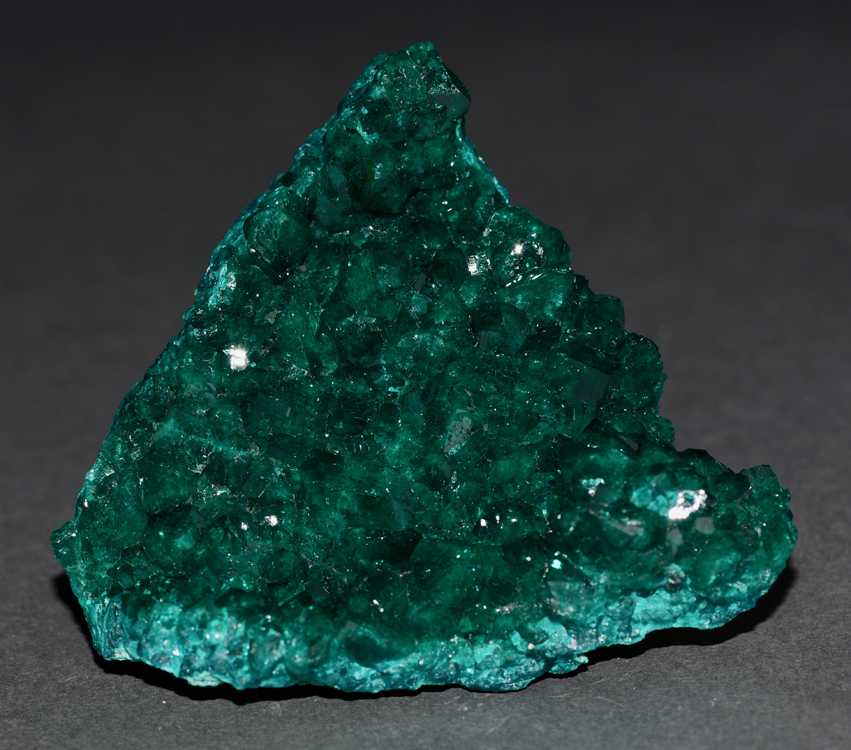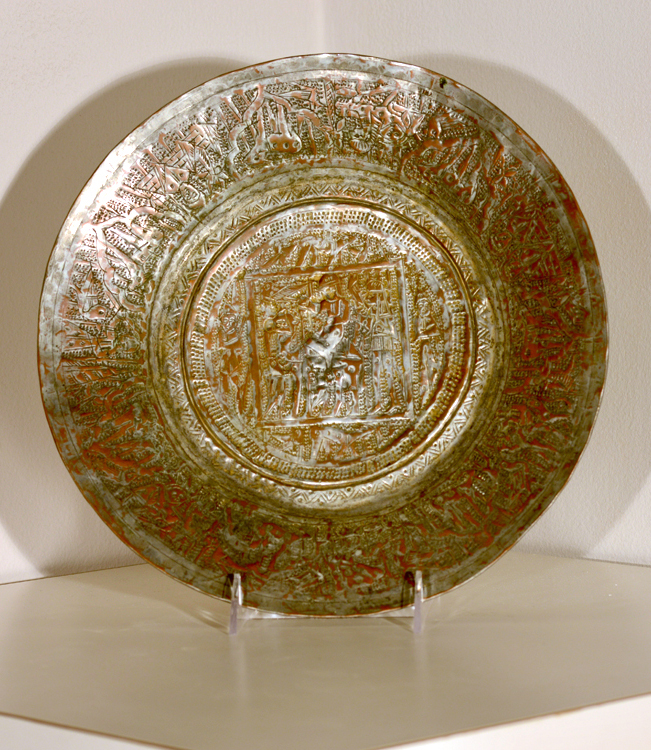
Copper (Cu) was known in ancient civilizations and was smelted with zinc to make brass and with tin to make bronze. Copper is an element that occurs naturally as crystalline copper. It also combines with other elements, making up other minerals, some of which are very colorful.
Unknown Maker
Betel Nut Cutting Utensil
India, ca. 1930 or earlier
Brass, 6 3/4 x 2 3/8 inches
Donor Unknown
Betel nut is the seed of the fruit of the areca palm, and is also known as areca nut. Betel nut chewing is ubiquitous throughout southeastern Asia, but is most widespread in India. The nuts are prepared by slicing the areca berries, and when the “chew” is combined with betel leaves it is referred to as paan. The chewing has similar effects as tobacco or caffeine, and like chewing tobacco, has carcinogenic effects on the mouth, gums, and esophagus. Although the source of this utensil is unknown, it is similar in style to other antique cutters from the 1930s or earlier.
Dioptase
Renéville Mine, Kindanba District, Republic of the Congo
3 1/4 x 3 3/4 x 1 inches
Dioptase was found at the Renéville Mine, before the mineral was found in greater abundance in Tsumeb, Namibia. A dark, bright green mineral, it is difficult to reproduce its true color in a photograph.
Azurite and Malachite
Bisbee, Warren District, Cochise County, Arizona
3 x 4 1/2 x 2 inches
Gift of Alvin B. Stiles
The azurite (deep blue) and malachite (green) specimen was found in the early days of mining in Bisbee and each is colored by the element copper. Specimens have been prized since the 1880s, before most of the vast copper deposits there were discovered. Miners and managers of the mines preserved specimens and built great collections, many of which are today in major museums. Although the most widely known minerals are azurite and malachite, more than 300 species have been discovered in the mines.
Unknown Greek Artist
Sparta Region, Greece
Double Spectacle Fibula, 9th-8th century BCE
Bronze, 5 x 5 inches
Gift of Mr. and Mrs. Samuel Eilenberg
A fibula is an ancient clasp used to secure clothing. The spirals are referred to as spectacles. There are four classifications of these fibulae, and this one is a Type IV, which is constructed in a one-piece manner. This differs from later examples of this type where the spectacles were attached separately to the pin mount. Multiple piece fibulae were found in the Greek Islands and Sicily. This one-piece variety was typical of an earlier time and was widely found in Sparta.
Copper
Houghton County, Keweenaw Peninsula, Michigan
2 1/2 x 6 1/2 x 3 inches
The spear-shaped specimen of the element copper is a twin crystal—two intergrown crystals. The possible crystalline shapes of copper are numerous, occurring in branching tree-like patterns or as cubes, dodecahedrons, or octahedrons. Thousands of Michigan copper specimens have been preserved in collections all over the world.
Unknown Artist
Italy
Chimera Medallion/Amulet, 15th-17th century
Bronze, 2 7/8 x 2 3/8 inches diameter
Donor Unknown
There is sometimes confusion about the difference between a Chimera and Gryphon (Griffon). A gryphon is a combination of lion and eagle, while a chimera is a composite of many animals. This medallion is likely a chimera as it has the body of a lion, wings of an eagle, and the head and neck of a serpent or dragon.
Bayldonite
Tsumeb Mine, Tsumeb, Oshikito Region, Namibia
3 1/2 x 4 x 1 1/2 inches
Estate of Frederick A. Keidel
The bayldonite specimen is from early mining days in Tsumeb in the late 1800s and is from near surface parts of the deposit. The specimen was originally the mineral mimetite but over time was replaced by the mineral bayldonite. This transformation is called “pseudomorphism,” as the crystal shape is still that of mimetite, but the chemical composition is now the copper mineral bayldonite.
Unknown Artist
Italy
Miniature of a Medici Lion, 17th century
Bronze, 2 1/8 x 1 7/8 x 1 1/2 inches
Gift of Mr. Alan Gerdau
This bronze sculpture is modeled after a Medici lion. The Medici lions are a pair of marble sculptures. One is Roman, dating to the 2nd century CE, and the other is a 16th century companion piece. In 1598 the lions were placed at the Villa Medici in Rome. Since 1789 they have been displayed at the Loggia dei Lanzi in Florence. The sculptures depict standing male lions with a sphere or ball under one paw, looking to the side. This miniature is one of many copies of the Medici lions that appear throughout Europe.
J. Harrison Wright (United States, dates unknown)
Bear, 1927
Bronze, 8 x 4 7/8 inches
Gift of the Gorham Corporation
Like other sculptures in this exhibition, this bear is another example of a small animal figure cast at the Gorham Foundry.
Unknown Artist
Egypt
Thoth Ibis Effigy, 600-300 BCE
Leaded bronze, polychrome traces, 4 x 3 3/4 inches
Gift of Mr. Alan Gerdau
In ancient Egyptian culture the ibis was an incarnation of Thoth, who represents the moon, wisdom, speech, writing, science, and magic. An ibis’s main function was to serve as the counselor and healer to Horus, the son of Osiris. X-ray fluorescence analysis was performed on this ibis, and it was discovered that the bronze body is composed of 81% copper, 16% lead, and 1% zinc. The feet (a later addition) are a brass alloy of 82% copper, 11% zinc, 3% antimony, 2% lead, and 1% tin.
Malachite
Katanga Copper Crescent, Democratic Republic of Congo
1 1/2 x 3 1/2 x 1 1/2 inches
The stalactite of malachite has been polished in such a way that it does not display rough natural surfaces but shows the “eyes” in malachite.
Unknown Artist
France
Limoges Bowl, 17th century
Copper, enamel, 1 7/8 x 7 1/2 inches diameter
Gift of Mr. Alan Gerdau
This bowl is made of pure raised copper. It originated at Limoges, a region in southwestern France, noted for enamelware, porcelain, and fine china. The decoration is painted using enamels ground to a fine powder and mixed with a very small amount of binder, such as gum arabic. After painting, the vessel is fired at approximately 1100 to 1550 degrees Fahrenheit, which burns away the binder and fuses the enamel to the copper bowl. The bowl has been consolidated and inpainted in areas of enamel loss along the lower edge. Nevertheless, the large areas of the decorative sides and the whole of the central stag hunt scene in grisaille technique are intact.
George Edwin Bissell, Sr. (United States, 1839-1920)
Diogenes, 1906
Bronze, 24 3/8 x 14 3/8 inches
Gift of the Gorham Corporation
George Edwin Bissell’s best-known sculptural works are figural monuments commemorating Civil War leaders or other dignitaries. The Gorham Foundry cast this figure of Diogenes in 1906. Diogenes was a Greek philosopher known for holding a lantern and claiming to be on a quest for an honest man. Diogenes is considered to be one of the founders of Cynicism – a doctrine that supports a life in accordance with nature and rejects convention. It is unknown whether this figure was cast in any other size beyond the small form seen in this bronze.
Unknown Artist
Padua, Italy
Plaque, Centaur, 17th-19th century
Bronze, gilding, 2 1/4 x 3 3/8 inches
Gift of Mr. Alan Gerdau
In Greek mythology, the centaur was half-man and half-horse. These creatures represented barbarism and unbridled chaos and were frequently represented in Greek architectural sculpture and pottery decoration. The usage of this small plaque is unclear, but similar ones appeared as book cover inlays, commemorative medals, and architectural decoration.
Copper
Adventure Mine, Greenland, Ontonagon County, Michigan
2 x 3 x 2 inches
The specimen of copper is a single crystal that is perched on a matrix. The Adventure Mine operated from 1850 to 1917 for the mining of copper and was reopened for underground tours in the 1970s.
Dioptase
Reneville Mine, Kindanba District, Republic of the Congo
5 x 6 x 4 1/2 inches
Gift of David A. Byers
Unknown Artist
Altamirano, Guerrero Mexico
Carnival Mask, ca. 1900
Copper, polychrome, fabric, 14 1/2 x 12 1/2 inches
Gift of Geneva R. Steinberger
The use of masks and costumes was an important part of Mesoamerican cultures long before the arrival of the Spanish. This particular mask is made out of sheet copper, and was used during Carnival. Although many Carnival masks are made of leather and molded to the wearer’s face, this mask has been reverse hammered in a process called repoussé. In areas where it contacts the face, remnants of cloth have been adhered to shield the skin against heat buildup and oxidation of the copper.
Unknown Artist
Celtic Northern Europe
Anklet, 250-225 BCE
Bronze, 3 1/2 x 1 3/4 inches
Gift of Mr. and Mrs. Arnold Saltzman
Celts probably originated in southwestern Germany and eastern France, but then quickly migrated throughout northern Europe. This explains, in part, why anklets like these are found in so many locations. The round shape of this piece of jewelry indicates it was worn on the ankle, and not on the upper arm, where an oval bracelet would have provided a more appropriate design and a more snug fit. Although the metal is thin, it is also too large and weighty to wear on a wrist.
Unknown Artist
Syria
Engraved Plate, 17th-20th century
Silver gilded copper, 12 inches diameter x 1 1/2 inches high
Gift of Julius Carlebach
Along the edge of this engraved plate is a frieze of incised human figures and animals. The design at the center of the plate shows a man seated on a camel inside an incised square. The images are partly engraved and partially created using punchwork. The wear on the silver gilt is extensive and clearly shows the copper of the plate.
Unknown Artist
Probably Europe
Bell, 15th-17th century
Bronze, polychrome, 5 1/2 inches x 4 1/2 inches diameter
Donor Unknown
This openwork bell features the symbols of Matthew, Mark, Luke, and John, with their Latin names inscribed on a band above the Man, Lion, Bull, and Eagle. The bell is meant to be suspended and struck with a mallet, likely during Mass or other Christian rites, as it is constructed without a clapper. The deformation of the bell, now almost in the shape of a rounded square at its base, indicates it was probably struck in this manner for many years.
Unknown Hindu-Javanese Artist
Indonesia
Tooled Plate, 18th-19th century
Copper, 16 7/8 inches diameter x 1/2 inch high
Donor Unknown
The copper is so heavily oxidized on this plate that the engravings are difficult to discern. Visible elements resemble those on Indonesian shadow puppets, including foliate and animal motifs, tooling, and punchwork.






















